We’re all familiar with the Internet handwringing, maybe even wrung our own hands: in the good old slow days, people had the time to study a subject deeply. They could develop true expertise. Now (we fret), the Internet has made us all a mile wide and an inch deep, and everybody is being flushed away by a fire hose of information.
The counter argument is that all the ready information we now have access to serves to illuminate connections across disparate areas of human endeavor. It’s interdisciplinary! We’re not entering a new Dark Age (the optimists argue), but rather another Enlightenment, when new generations of Renaissance people will develop expertise in a variety of fields.
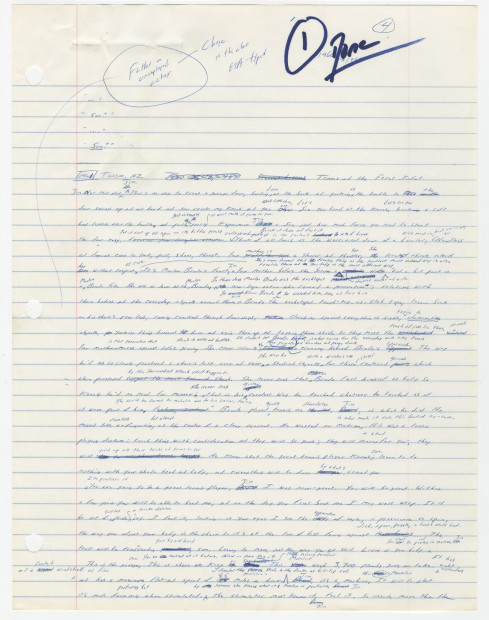
David Foster Wallace, first page of a handwritten draft of Infinite Jest. From the manuscripts collection at the Harry Ransom Center, University of Texas at Austin.

Praying mantises (Stagmomantis). From the Freshwater and Terrestrial Invertebrates collection, Texas Natural Science Center, University of Texas at Austin.
This cheerier view of our information-sodden age occurred to me not while surfing the web, but while poking through The Collections, the massive, engrossing, 900-page new book chronicling all the collections at the University of Texas at Austin. It’s an encyclopedia of the holdings at our state’s mega-university, and like the encyclopedias of yore, its subject matter ricochets from one page to the next, inviting the curious to trace similarities between science, history, art, film, law… pretty much every subject the university teaches is represented in this stunning tome. Just be sure to bend your knees when you lift it.
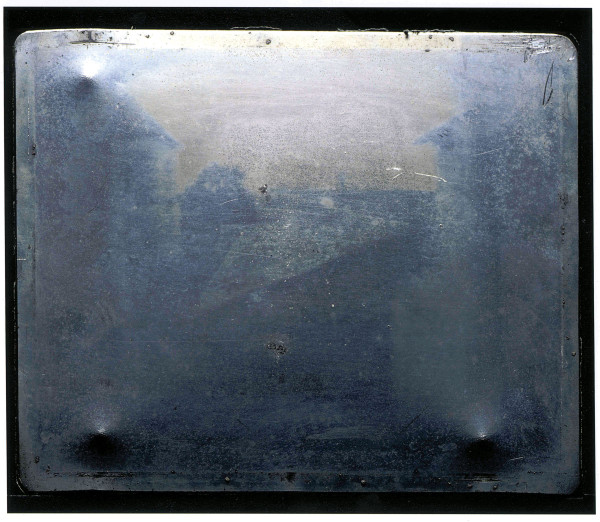
Joseph Nicéphore Niépce (1765 – 1833), View from the Window at Le Gras, 1826-27, heliograph. The earliest known photograph extant. From the photography collection, Harry Ransom Center, University of Texas at Austin.

Young NAACP members protesting at the Texas State Fair in Dallas. Photo by R.C. Hickman, October 17, 1955. From the Civil Rights and Social Justice collection at the Dolph Briscoe Center for American History, University of Texas at Austin.
By “all collections” they really do mean all: not just the art in the Blanton Museum and the treasure trove that is the Harry Ransom Center, but the scientific specimens, historical documents, archaeological artifacts, patent models… with roughly 170 million objects in the collection, it turns out that UT’s holdings dwarf those of the Smithsonian (which has 135 million), according to the book’s editor Andrée Bober.
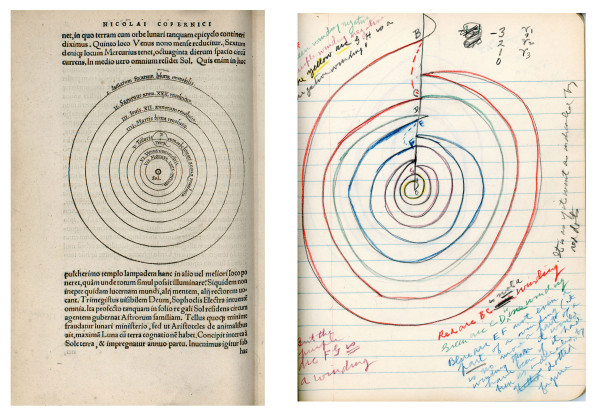
L: Nicolaus Copernicus, De Revolutionibus orbium coelestium, 1543. First edition of the first book to set forth the theory of a sun-centered solar system. From the books collection, Harry Ransom Center, University of Texas at Austin. RT: Page from R.L. Moore notebook, “Concerning Windings,” 1953. From the Archives of American Mathematics, Dolph Briscoe Center for American History, University of Texas at Austin.
I spoke with Bober recently about this massive project, a 12-year labor of love that she envisioned and oversaw as a volunteer (the university didn’t commission the book, nor was she paid for the work). Bober’s day job is director of Landmarks, the public art program at UT Austin, where she has overseen the commissioning of works by Sol Lewitt, Casey Reas, Ben Rubin and Nancy Rubins, among others; as well as the collaboration with the Metropolitan Museum of Art, which has resulted in dozens of artworks on campus on long-term loans. Basically, she’s the reason there’s art on campus that’s not bronze statues of Confederate leaders.
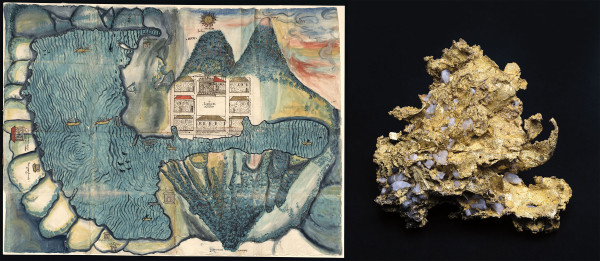
L: Santiago Atitlán, Relaciones Geográficas of Mexico and Guatemala, ca. 1585. From the Nettie Lee Benson Latin American Collection, University of Texas Libraries. RT: Native gold, Mexico, From the Barron Mineral Collection, Texas Memorial Museum, University of Texas at Austin.

King and Carter Jazzing Orchestra, Houston, Texas, 1921. From the Music and Entertainment collection, Dolph Briscoe Center for American History, University of Texas at Austin.
In the mid-aughts, Bober began poking around the university and realized there was no single registry of all the collections held there. Many of these collections are very well-known and respected within their discipline, but you wouldn’t know of their existence if you weren’t, say, an expert in the history of vacuum tubes. “I was continually surprised by things I didn’t know existed at the university. The treasures aren’t hidden, but they’re very elusive,” she said.

Class: Red algae (Florideophyceae); Strain: Spyridia filimentosa. From the Culture Collection of Algae, College of Natural Sciences, University of Texas at Austin.
As an example, Bober cites the Culture Collection of Algae, the largest and oldest collection of its kind. It includes thousands of living algae culture strains, which researchers all over the world use for food production, water decontamination and medical research. It lives in the College of Natural Sciences. But if you don’t typically deal with algae outside of Japanese cuisine—if, for instance, you generally only visit the Blanton Museum of Art when you go to UT—then you’d have no idea about this valuable cache of living organisms. Until now.
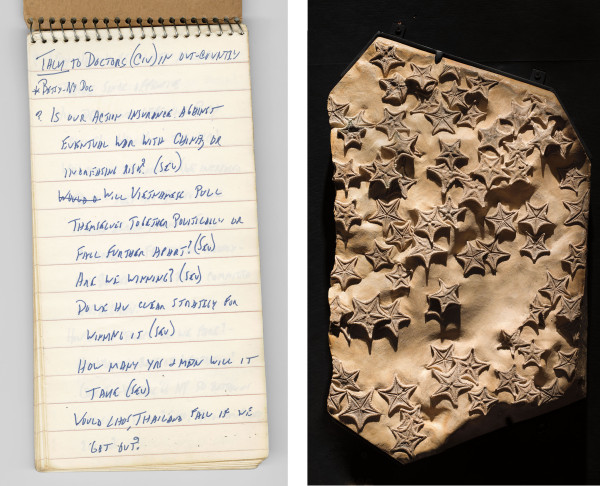
L: First page of a notebook kept by CBS News reporter Walter Conkite during the Vietnam War Tet Offensive, February 1968. From the American News Media History collection, Dolph Briscoe Center for American History, University of Texas at Austin. RT: Fossil starfish (Crateraster mccarteri; originally Austinaster mccarteri), Texas, Mesozoic period, about 142-62 million years old. From the Non-vertebrate Paleontology and Geology Laboratory, Texas Natural Science Center, University of Texas at Austin.
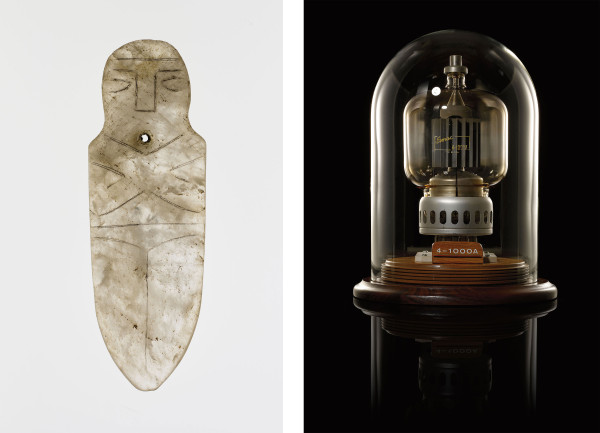
L: Incised effigy, Coral Snake Mound, Louisiana, ca. 200 BCE-500 CE. From the Texas Archeological Research Laboratory, College of Liberal Arts, University of Texas at Austin. RT: Radial beam forced air-cooled VHF triode, ca. 1956. From the Ohmes Vacuum Tubes collection, Cockrell School of Engineering, University of Texas at Austin.
[As for the art, the Blanton has already produced several comprehensive catalogs of its collection. But I would argue that this new book inadvertently demonstrates how uneven and relatively limited UT’s holdings are. UT may have the largest university art collection in Texas, but when you think of the great university collections in the country — Harvard’s being the gold standard — you realize how far Texas has to go. ]
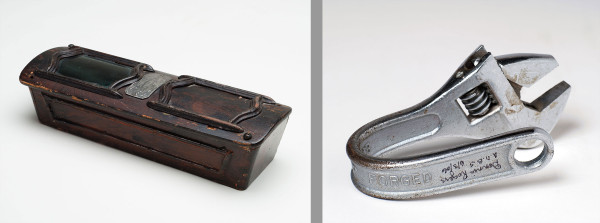
L: Isaac C. Schuler, Burial case, patent no. 115,116, May 23, 1871, 2×7 inches. From the Patent Models collection, School of Law, University of Texas at Austin. RT: Crescent wrench bent by professional strongman Dennis Rogers, 2006. From the H.J. Lutcher Stark Center for Physical Culture and Sports collection, College of Education, University of Texas at Austin.

Kponyungo mask, Ivory Coast, 20th century. From the John L. Warfield Center for African and African American Studies, College of Liberal Arts, University of Texas at Austin.
Perhaps the issue isn’t the amount of information these days, it’s the speed at which we’re expected to absorb it. As a compendium (beautifully photographed primarily by San Antonio artist Mark Menjivar), this book approximates what it might feel like to poke through dusty cabinets all over campus. Like all wonderfully rich cabinets of curiosities, The Collections rewards slow and repeated looking.



2 comments
But does it include the beer can collection in 1095 Jester?
A glaring omission, apparently.